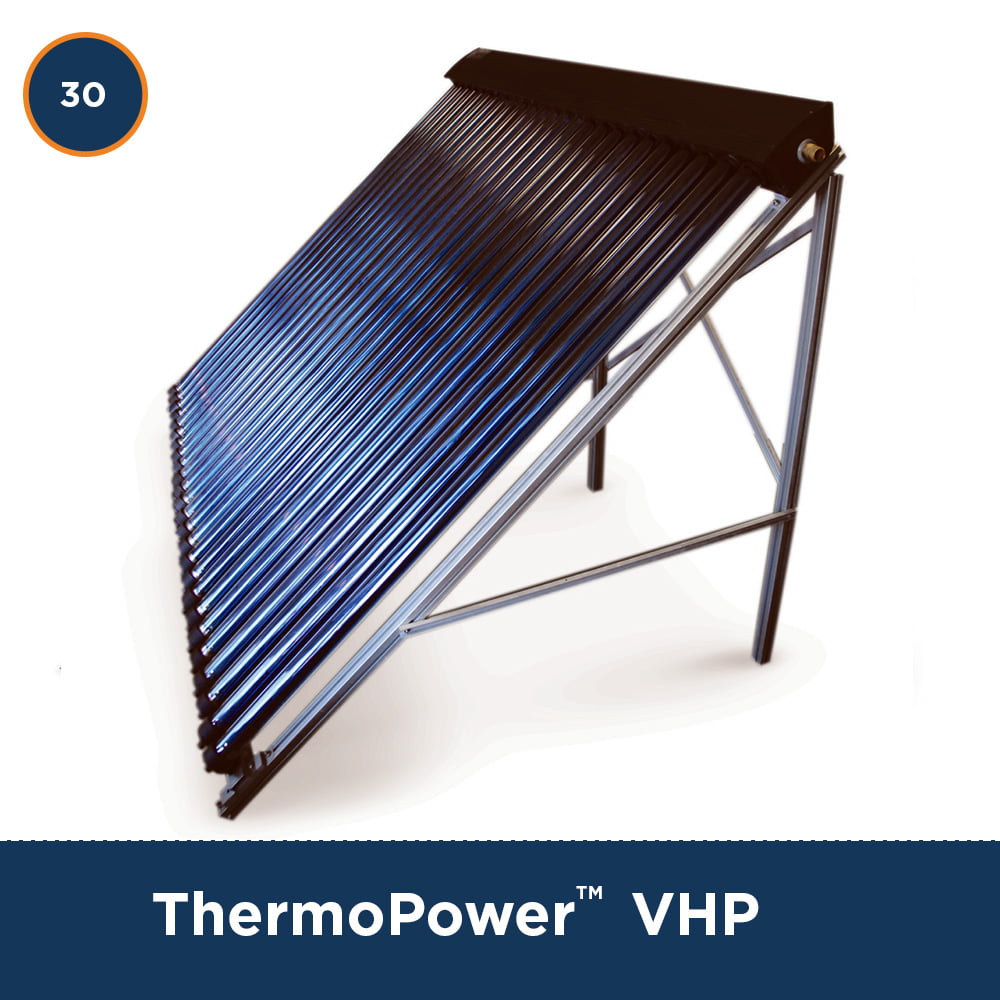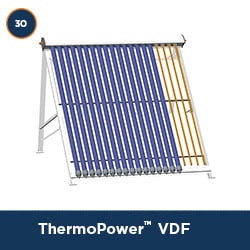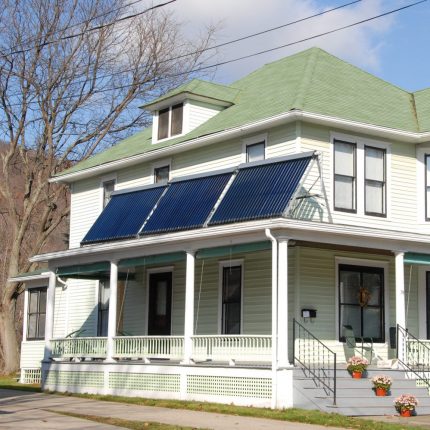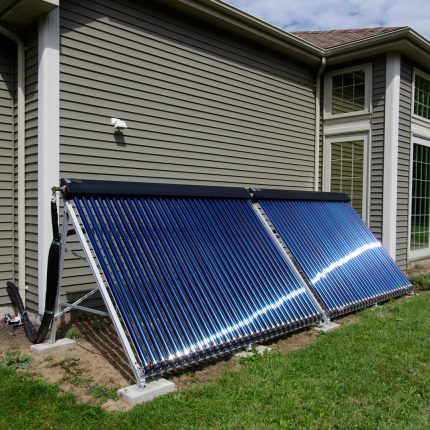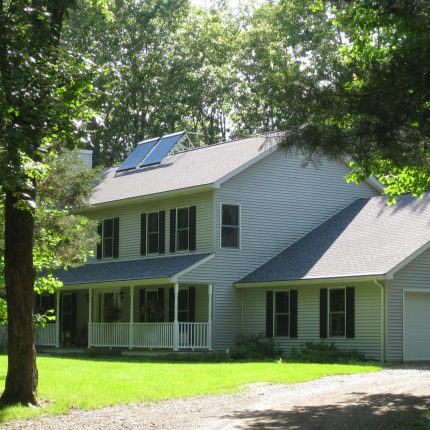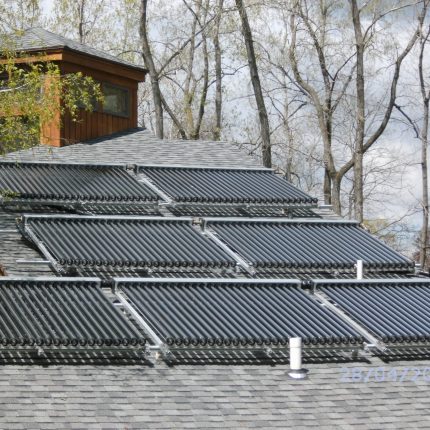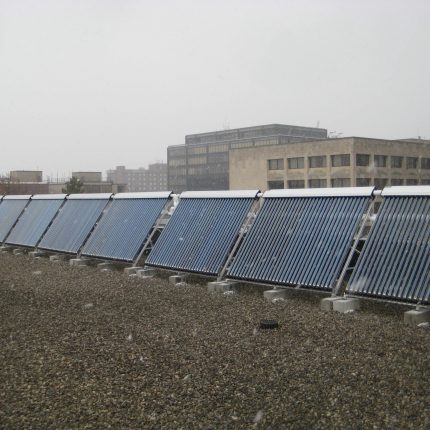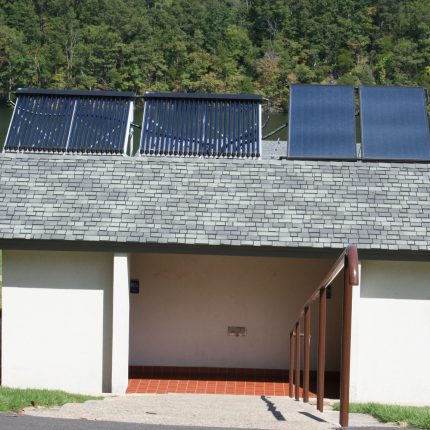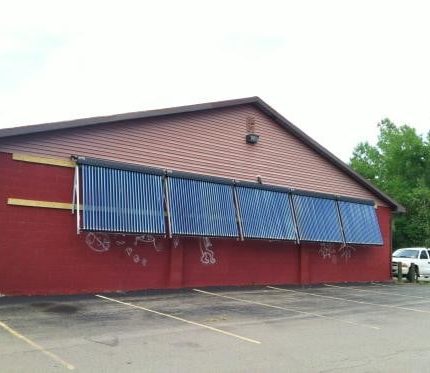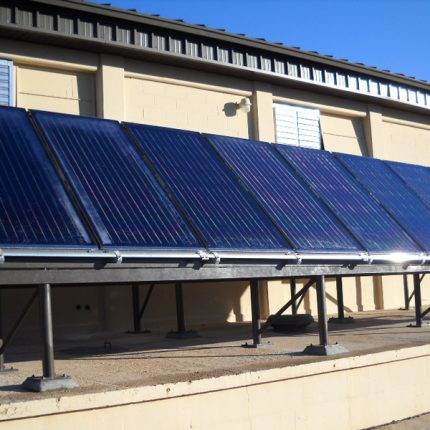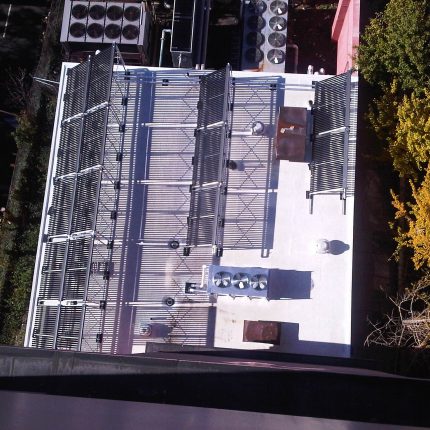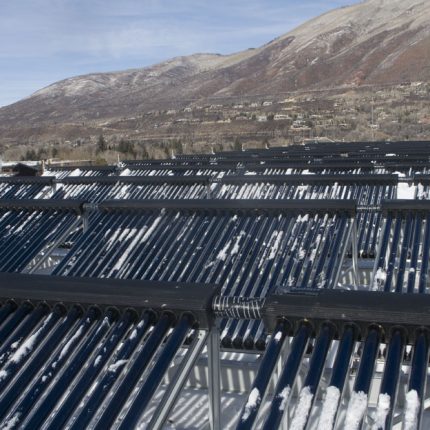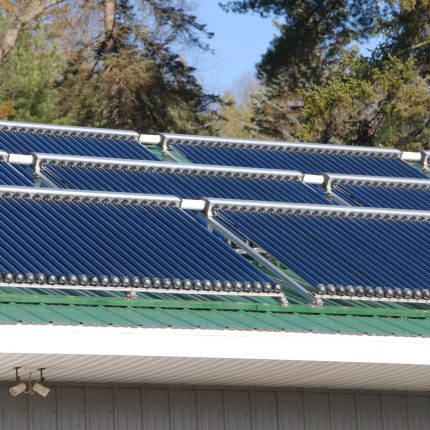Evacuated Tube Solar Collectors
AVAILABLE NOW
VHP Evacuated Tube Collectors
Evacuated Tube Solar Collectors are extremely efficient and cost-effective; particularly in colder climates, where other solar collector designs suffer from reduced performance and a variety of other problems due to their lack of freeze protection. Evacuated Tube Collectors, unlike other designs, are extremely well-protected from low temperatures, leading to efficiencies of over 70% even in sub-zero climates, ensuring your water stays hot no matter how cold the weather is.
- Suitable for industrial & process heating
- Certified for federal solar tax credits
- Modular & easy to install
| Model | ThermoPower-VHP20 | ThermoPower-VHP30 |
|---|---|---|
| Dimensions (in) | 70.2" x 79" | 102.9" x 79" |
| Gross Collector Area (sqft) | 37.4 | 56.4 |
| Net Aperture Area (sqft) | 21.4 | 32.1 |
| Weight (lbs) | 170 | 252 |
| Flow Rate (GPM) | 0.56 | 0.84 |
| # of Tubes | 20 | 30 | LEARN MORE | LEARN MORE |
AVAILABLE NOW
VDF Evacuated Tube Collectors
SunMaxx Evacuated Tube Solar Collectors are designed to efficiently provide hot water for a number of applications, in a wide variety of climates and locations. SunMaxx customers use the SunMaxx VDF30 for domestic hot water radiant heating and pool/hot tub heating every day at residential, commercial/industrial, and municipal locations.
- Mount flush or vertical
- Glass tubes & manifold pre-assembled
- Certified for federal solar tax credits
| Model | ThermoPower-VDF20 | ThermoPower-VDF30 |
|---|---|---|
| Dimensions (in) | 60" x 64.7" | 87.4" x 64.7" |
| Gross Collector Area (sqft) | 26.95 | 39.33 |
| Net Aperture Area (sqft) | 19.26 | 28.84 |
| Weight (lbs) | 115 | 170 |
| Flow Rate (GPM) | 0.4 | 0.6 |
| # of Tubes | 20 | 30 | LEARN MORE | LEARN MORE |
AVAILABLE NOW
VTS Evacuated Tube Collectors
Our DIY residential solar hot water systems are complete, ready-to-install packages that will provide affordable and efficient solar hot water in regions where cold weather isn't often seen. Each system includes a high-efficiency solar collector and integrated water storage tank for an effective combination of simplicity and affordability.
Our DIY residential solar hot water systems are complete, ready-to-install packages that will provide affordable and efficient solar hot water in regions where cold weather isn't often seen. Each system includes a high-efficiency solar collector and integrated water storage tank for an effective combination of simplicity and affordability.
- No moving electric motors
- Certified for federal solar tax credits
- Easy to install as DIY solar hot water system
| Model | ThermoPower-VTS15HP | ThermoPower-VTS30HP |
|---|---|---|
| Dimensions (in) | 60" x 90" | 109" x 90" |
| Gross Collector Area (sqft) | 24.5 | 47.9 |
| Capacity (G) | 40 | 79 |
| Weight (lbs) | 143 | 265 |
| Flow Rate (GPM) | 0.3 | 0.6 |
| # of Tubes | 15 | 30 | LEARN MORE | LEARN MORE |
Related Documents & Downloads
Features & Benefits
- SRCC OG-100 Certified For Guaranteed Performance
All of our collectors are SRCC tested and OG-100 certified, meaning that you can buy with confidence in the fact that our products will deliver the performance you pay for.
- Network Of Dedicated, Professional Installers
We have trained and certified more than 3,000 independent solar hot water installers and service professionals, both across the United States around the world, ensuring that professional help for your SunMaxx solar thermal system is never more than a phone call away.
- Residential Domestic Hot Water & Radiant Systems
Our evacuated tube collectors are great for a variety of residential solar heating applications, including: traditional hot water systems, radiant/space heating, and pool/spa heating.
- Commercial & Municipal Solar Heating Systems
Our evacuated tube solar collectors are in use in commercial, municipal, educational, and military solar hot water and heating systems of every shape and design, across the United States and around the world.
Questions?
Ready To Get Started?
Get more information or order our Evacuated Tube Collectors:
Important Notice:
The following models have been discontinued or are special order items only. (click to view alternative models):
Instructive videos
How do evacuated tubes work in the winter?
Evacuated tubes, an essential component of SunMaxx Solar hot water systems, are designed to function optimally in all seasons, including the winter months. Here's a simplified explanation of how they work when temperatures drop:
Insulation: Each evacuated tube comprises a double-layered glass tube with a vacuum in between. This vacuum acts as an excellent insulator, reducing heat loss to nearly zero, thus maintaining the efficiency of the system even in freezing weather.
Absorption: The inner layer of the tube is coated with a special solar-absorbing material that captures sunlight and converts it into heat. This layer is designed to absorb the maximum amount of solar radiation, including during shorter winter days.
Heat Transfer: Inside each tube, a heat pipe transfers the generated heat to a manifold, which then circulates the hot water or heat transfer fluid to your storage tank. The evacuated tube design prevents the heat from escaping back into the cold atmosphere.
Orientation: Even when the sun is low in the winter sky, the cylindrical shape of evacuated tubes allows for optimal absorption of sunlight throughout the day.
In summary, the insulating vacuum, solar-absorbing coating, efficient heat transfer, and cylindrical design all contribute to the effective operation of evacuated tubes in the winter. While there may be less overall sunlight in the winter months, SunMaxx's evacuated tubes are engineered to make the most of available sunlight.
What are the problems with evacuated tube solar collectors?
Evacuated Tube Solar Collectors FAQs1. What are Evacuated Tube Solar Collectors? A. Evacuated tube solar collectors are a type of solar thermal energy technology that consists of tubes made of glass that are sealed with a vacuum. The vacuum helps to reduce heat loss, making them more efficient than conventional solar collectors.2. How do Evacuated Tube Solar Collectors Work? A. Evacuated tube solar collectors absorb solar energy from the sun, and the tubes act as heat absorbers and insulators to store the heat. The heat is then transferred to a thermal storage system, such as a hot water tank, which can be used for a variety of applications.3. What are the Benefits of Evacuated Tube Solar Collectors? A. Evacuated tube solar collectors have numerous advantages, such as: - High efficiency, since they reduce heat loss due to their vacuum-sealed design; - Low maintenance requirements; - Can be used in a variety of applications; - Can be combined with other solar energy systems to increase efficiency.4. What are the Problems with Evacuated Tube Solar Collectors? A. Evacuated tube solar collectors may not be suitable for all climates, as they can be affected by extreme temperatures. Additionally, the tubes are fragile and may require an additional protective layer for outdoor installations, and the cost of installation can be quite high. Evacuated tube solar collectors have some drawbacks, including:- Higher initial cost: These collectors are typically more expensive upfront compared to flat-plate collectors, due to their complex design and manufacturing process.
- Fragility: The glass tubes can be fragile, requiring careful handling during installation and maintenance to prevent breakage.
- Replacement cost: If a tube breaks or loses efficiency, it needs to be replaced, which can be more expensive than replacing a component of a flat-plate collector.
- Aesthetics: Some people may find the appearance of evacuated tube collectors less visually appealing than flat-plate collectors, as they have a more industrial look.
- Space requirement: Evacuated tube collectors may need more roof space compared to flat-plate collectors for the same energy output, due to their cylindrical shape.
- Installation and maintenance: They may require specialized skills for installation and maintenance, which could result in higher service costs.
The Science of Evacuated Tubes
The science of evacuated tubes. Short introduction on how they work.
Part 2 of this webinar series.
How to change or replace heat pipes in evacuated tube collector
Quick video on how to replace your evacuated tube heat pipes (replace or to remove if you have issues with producing too much heat!) .
FAQs - Evacuated Tube Collectors
While both types of collectors capture the suns energy and convert it to hot water each have there own advantages.
Evacuated Tube Collectors are best used in northern climates where freezing can occur and can be utilized in areas where temperatures drop down to -60°F. Evacuated Tubes are are extremely efficient by virtue of the Tubes themselves. Each Evacuated Tube is hermetically sealed meaning it is highly insulated due to the fact that it is a sealed atmosphere nearly impervious to outside temperatures. Evacuated tubes can also be replaced if damaged, simply by plugging it in, no need to replace the whole unit.
SunMaxx Flat Plate collectors use a highly efficient flat absorber material called Tinox which transfer heat to a series of copper tubes which circulate a 50% glycol/water mix. The collectors themselves are in essence a a sealed insulated box which captures the suns energy and transfers it via the Tinox, then through the pipes filled with glycol and into the storage tanks.
Yes you can. Collectors can be attached to our ballast system, which uses the weight of standard patio blocks to hold the collectors in place. Wind load calculations must be done by an engineer to conform to local building codes. With the proper weight attached, collectors will stay in place without putting any holes in the roof. This has been done with our evacuated tube collectors and our flat plates. Flat plates obviously have a much higher wind resistance, and therefore require greater weight to hold them in place. Our ballast system will work with photovoltaic panels as well.
There are no guarantees with rafters when it comes to distance apart or consistency. The easiest way to deal with this problem is using the ConnectMaxx rail system. Our roof mounts can be secured where the rafters are, and then our rails can be secured to the roof mounts. All of our collectors can then be secured anywhere along the rails using sliding blocks. When using SunMaxx rails, you can worry less about where the rafters are and more about where you want your collectors!
This answer depends on what you are trying to accomplish. For simple Domestic Hot Water systems you should try and position you collectors at the same angle as your latitude. For systems that are tied into the home heating system, as in a combisystem, you should position you collectors 15 degrees higher than your latitude. For summertime use only systems, as in a pool system, you should position your collectors at your latitude minus 15 degrees.
For systems that have a high solar fraction, i.e. 75% or greater, you should increase the angle of incline in order to decrease your summertime production slightly.
Do you want to make this system perform to its highest ability or should it look nice and fit the architecture of the house?
We have all seen those albatrosses on the roof that are cantilevered at a compound angle to get a few extra BTU’s at the cost of aesthetic appeal. Here are some guidelines to consider when deciding what is most important in determining collector orientation and inclination.
For most collectors, tubes or flat plates, the angle of inclination has a 30 degree window of variation and the performance will still be within 95% of the expected maximum. That is, if your collectors should be mounted at 55 deg then you can mount them between 40-70 while losing only a small fraction of energy gain.
As for the collector orientation, that window is 60 degrees for Evacuated tubes and 30 degrees for flat plates. These considerations allow you to fit the collector to most homes’ pitch and orientation without losing too much energy gain.
Obviously you want your client to get the most out of it, but you are more likely to get additional jobs if the collectors are mounted in a way that takes into account the aesthetic appeal. Ask your Sunmaxx Representative for a copy of the Inclination and Orientation performance Chart so you can make informed decisions.
Yes it is. Depending on your type of collector, you can program your controller to manually activate the circulator which will bring heat from your storage vessel and into the collectors, which will radiate that heat back out thus melting the snow. This method only works for FLAT PLATES however and will usually take as much energy as it makes. When the sun is out in full force, the rays passing through thge snow are typically enough to create substantial heat that in turn, melts the snow on flat plates.
For Evacuated tubes however, there is very little you can do to melt the snow. If your collectors are sitting at a tilt off from the roof pitch, you should be okay because the snow will pass between the tubes onto the roof. But for flush mount EVT systems, snow can and will build up. However, in my experience, this will only affect the output for a day or two. Becuase if the sun is out enough to make any amount of BTU”S then there will be enough heat wasted at the roof/collector interface that begins to melt the snow alowing it to slide down from the top of the tubes. With only minimal exposure to the direct sunlight, the small amount of exposed tube will begin to yield significant amount of BTU’s, even though they are mostly covered. So for tubes, dont sweat it, you are not going to lose much unless of course they get covered by a couple feet or so then perhaps you’ll want to sweep them off if you can.
This will be a debate well in to the future. For an more in-depth review please watch this Click here to watch this 1/2 hour webinar. Your decision should be based primarily on the following considerations:
- Temperature demand– What is you existing application? EVT’s will outperform FP’s at higher temp load.
- Climate location- In a general sense, flat plates have more value than evacuated tubes in warmer climates and EVT’s will do better in cold, cloudy climates.
- Aesthetics appeal– This is where there is no “right” answer. Instead, each person has their own personal view. We recommend that you go with it. If they prefer flat plates for that reason then you install flat plates and if they prefer evacuated tubes for their aesthetic appeal, then by all means, you should install Evacuated tubes.
The point is, you really CANT GO WRONG. Each type will yield significant value and in the end, the differences will be negligible.
Fortunately, solar thermal collectors are not nearly as sensitive to light conditions as PV collectors. As for performance, you have roughly a 60 degree window of opportunity to mount the collectors toward south before you begin losing a small bit of total production. In other words, your house can be situated 30 to the east of true south or 30 degrees to the west of true south and your performance will still be at or above 95%.
As far as tilt angle goes, this window opportunity is slightly smaller but still you can have a roof pitched about 20 degrees plus or minus of your particular latitude angle and you will still see results at or above 95% of expected.
Ask a SunMaxx rep to run a Polysun report for your particular conditions to be sure, you will be happy you did and pleasantly surprised.


